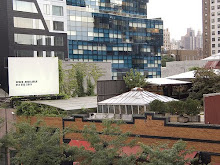
 1) Union Square in December with tents of Holiday Market, 2009. 2) Union Square Archival Image: Illustration of Union Square Park in mid-1800s.(Columbia University Park Story Project).
1) Union Square in December with tents of Holiday Market, 2009. 2) Union Square Archival Image: Illustration of Union Square Park in mid-1800s.(Columbia University Park Story Project).
Location: From East 14th Street to East 17th Street between Union Square West and Union Square East. Union Square E becomes Broadway north of the park and is University Place to the south. Similarly Union Square E becomes Park Ave North of the park and is Broadway to the south.
Transit: Accessible by the L, N, Q, R, W, 4, 5, and 6 trains.
For well over a hundred years Union Square Park has been a site for people to lounge, congregate, protest, rest, and more. Our current perception of the park often overlooks the important historical events that have taken place there. The park was built in the 1830s after the Common Council purchased private property to establish an open space (Shapiro). Before the space was made into a public park, it had been co-opted by the wealthy and regarded as separate private space kept “beautiful” by normative standards and by the exclusion of common people. At this time, the park was demarcated by fences positioned against a densely populated city. In 1872, Frederick Law Olmsted redesigned the park to be more accessible to all people by taking down the fencing and creating more open space for mass public gatherings. This led to diverse ethnic groups and lower income citizens to mingling among other classes and allowed Union Square to become a site of political agitation.
In fact, Union Square has a long history as a center for political protest, activism and strikes. The first official Labor Day occurred in Union Square in 1882. At this time the holiday was not a celebration, as it is today, but a protest of twenty-five thousand people demanding an end to the use of child labor, an eight-hour workday, and many also advocating an end to rent obligations (Kayton). In 1886 on International Workers Day thirty thousand gathered in the square. Numerous other protests also attracted tens of thousand of people to protest injustices such as depression era conditions, workers' deaths in strikes, state executions, war, and unfair elections (Kayton). Using Daniel Opler’s definition of a strike as a “cultural act” used by workers to impart and spread their message to other workers, it is clear how important a public protest space is to further proletariat political movements and also clear why the space was now dangerous to those in power. The use of Union Square as a communal gathering space of “radical people” who pose a threat to both the governmental and economic status quo was ended by the 1980s.
During the 80s the city spent $3.6 million in renovations on the Park (Kayton). The renovations both caused and coincided with the surrounding areas transformation from one characterized by “low-rent office buildings, inexpensive stores, and single-room occupancy hotels” (Deutsche) into the Union Square area of today inundated with chain stores and luxury commercial and residential spaces. Coinciding with the renovations to the Park, New York lost over 100,000 blue-collar jobs and “gained over twice that many in the finance, insurance, and other business industries” (Deutsche). At the same time the city was trying to attract an increasingly wealthy population, it was displacing the people who inhabit Union Square, (the homeless) and the surrounding community, by out pricing them through the active encouragement of gentrification. The renovations to the park created a sanitized version of the formerly revolutionary space and paved the way for upscale commercialization. The erasure of Union Squares’ history of social spirit, movements, and protest highlights the connection between architecture, politics and economics.
- Clare Delaney and Upahar Rana
Deutsche, Rosalyn. “Krzysztof Wodiczko’s ‘Homeless Projection’ and the Site of Urban ‘Revitalization.’” October Vol 38 (Autumn, 1986) 63-98.
Kayton, Bruce. Radical Walking Tours of New York City. New York: Seven Stories Press, 2003.
Opler, Daniel. “Money Business in Union Square: A Cultural Analysis of the Klein’s-Ohrbach’s Strikes of 1934-5.” Journal of Social History Vol. 36 No. 1 (Autumn, 2002) 149-164.

No comments:
Post a Comment